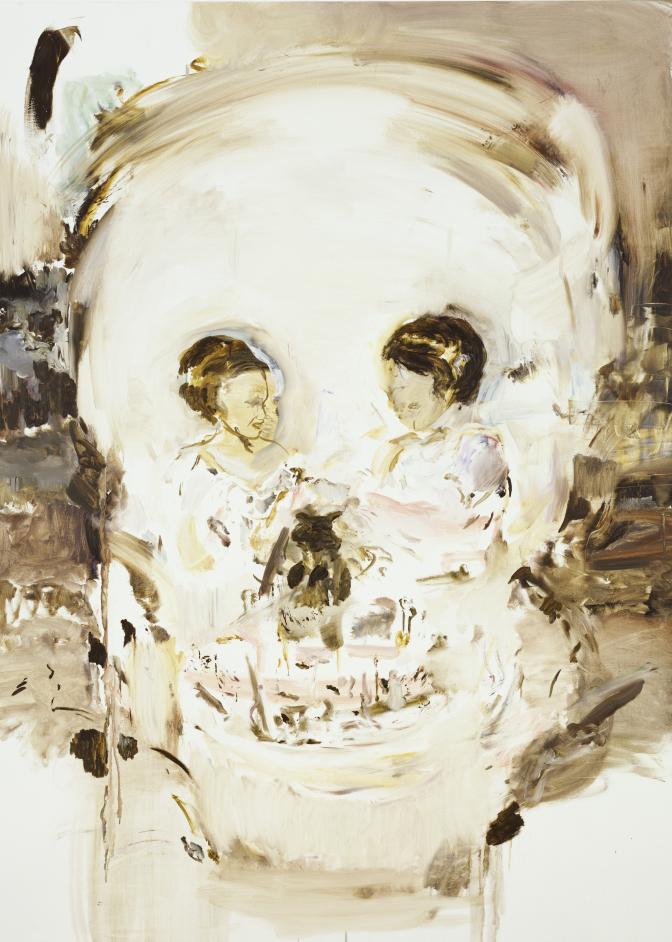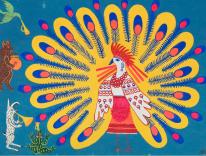Like many of Cecily Brown’s paintings, Vanity Shipwreck (2021–22) sits uneasily between figuration and abstraction. Visually, it both repels and attracts. At first, it appears chaotic and disorganized, a foaming churn of anxious whitewater that thwarts viewers’ attempts to find a way in. That’s especially true on the canvas’s upper right, where Brown’s harried brushwork haphazardly traces compressed waves and frenzied streaks in muted blues, greens, yellows, and whites. Is there anything meaningful in this riot of paint? Maybe not: our gaze founders, and we’re tempted to give up and look away.
But recognizable shapes and patterns soon begin to emerge. There’s a large chest floating on the lower right, while a small ship’s rudder, curved anchor, and cruciform mast occupy the upper left. Seated on a bench a little left of center is a nude blonde woman with her back to us. We can’t quite make out what she’s doing: Is she staring at herself in a mirror? Or painting a portrait of another woman, whose gaping mouth is possibly screaming, or singing, or neither? Despite this ambiguity (perhaps because of it), the blonde woman’s stable, erect posture conveys a sense of meditative calm, a confidence that radiates outward, rebalancing the entire painting. In relation to her upright body, the foaming waves no longer threaten or overwhelm; everything in this pulsating mass of paint becomes beautiful and still.
Born in England in 1969 to a novelist mother (Shena Mackay) and an art-critic father (David Sylvester), Cecily Brown attended London’s Slade School of Fine Art before quickly rising to art-world prominence after her permanent move to New York in the mid-nineties. Since then, Brown has achieved a level of critical and commercial success that’s still relatively rare for a living female artist. Her paintings, many of them executed at monumental scale and exhibited in grand public venues like the Metropolitan Opera House in New York and the Museo e Real Bosco di Capodimonte in Naples, regularly sell for millions of dollars.
Collaboratively conceived by Brown and curator Ian Alteveer during the pandemic, Cecily Brown: Death and the Maid is the artist’s first major museum exhibition in New York. The show includes around fifty paintings, drawings, sketchbooks, and monotypes made during the past twenty-five years. With its sprawling galleries and encyclopedic collection, the Met serves as a fitting venue for Brown’s art, which regularly absorbs and transforms fragments from the whole sweep of European art history, from old masters like Velazquez, Rubens, and Rembrandt, to modernists like Manet and Soutine, to abstract expressionists like de Kooning and Pollock. The show is small for a mid-career retrospective, but that doesn’t make it any less powerful. Like a seventeenth-century Kunstkammer, or cabinet of curiosities, the show’s packed, windowless (and benchless) galleries literally overflow with paintings and visitors, underscoring the electrifying excess (“overripe abundance,” one wall text calls it) that lies at the center of Brown’s painting.

Eschewing chronology, the show groups small clusters of Brown’s works into two separate but intertwined themes: vanitas, or the ineluctable vanity of human life, and still lifes (ironically called, as the catalog notes, “nature morte” in French). Among the most accessible and arresting canvases in the vanitas section is Aujourd’hui Rose (2005), a large trompe l’oeil painting of a grinning, cream-pink skull whose brownish-yellow eye sockets are formed by the heads of two small girls holding a puppy, which in turn comprises the skull’s nasal cavity (their ruffled dresses form a row of crooked teeth below). Brown’s source is a popular Italian photographic postcard from 1900, in which an ominous inscription hints at the eventual ruin lurking behind even the happiest times: “Aujourd’hui rose, demain…” (Today pink, tomorrow…). The original image is kitschy, but the delicate attention Brown lavishes on the crown of the skull—a long, blurry smear of cream-colored paint—is quietly moving. As if caressing death with her brush, Brown invites us to find beauty’s impermanence worthy of admiration.
Brown revels in annihilation in other paintings, too. Memento Mori I (2006–8), featuring a cramped interior scene dominated by a billowing avalanche of pastel colors, pays homage to Heinrich Hoffman’s Victorian-era nursery tales. One presents “Fidgety Phil,” a boy who rocks back and forth in his chair at the dinner table with his stern parents. Unable to sit still, Phil loses his balance and latches onto the tablecloth for support, sending everything—dishes, plates, utensils, food—crashing to the floor. Like many Victorian fantasies (Brown’s 2006 The Picnic, also included in the show, adapts Lewis Carroll’s Alice in Wonderland), Phil’s story holds a grim moral for its young audience: misbehavior breeds catastrophe, so conform and obey. Brown’s painting reverses this message by lavishing smooth brushwork and soothing colors on the spinning dishes and falling utensils, rendering everything else (Phil’s mother with her hand on her hip, his wooden chair) in clumsy, clashing strokes. It’s as if Phil’s rebellion has become an act of creation, and a declaration of freedom.
Brown enacts a similar reversal in her paintings inspired by Dutch still lives, a genre that flourished in the seventeenth century, when artists and patrons from the Netherlands began confronting the social contradictions arising from their booming mercantilist economy and iconoclastic Protestant morality. Painted with hyperrealistic precision, those works featured ornate tableware made of precious materials stuffed with sumptuous delicacies like lobster and oysters. Other objects like spent candles, peeled fruit, and wilting flowers reminded viewers of the fleetingness of such earthly pleasures and the possible sinfulness of their appetites. Brown’s spiral-bound sketchbooks, housed in table-like display cases, reveal her particular fascination with the still lives of Flemish painter Franz Snyders (1579–1657). The drawings—which foreground the limp carcasses of flayed rabbits, plucked geese, and groaning boars’ heads that frequently appear in Snyders’s work—highlight not just Brown’s virtuosic figural technique, but also the violence undergirding such displays.

Paintings like Nature Morte (2020) and Lobsters, Oysters, Cherries, and Pearls (2020) push this a step further. Both canvases are awash in glowing blood-red paint, overpowering the yellow lemons and black cat crouching beneath. Instead of critiquing this extravagance, though, Brown luxuriates in it. The frameless sides of Nature Morte are particularly telling. On the right, strings of oil paint drip down the linen; on the left, we find a clutch of fingerprint smudges, presumably Brown’s, as if seizing the plenitude of paint with her bare hands.
Is Brown then an aesthete, interested in nothing more than the excitement brought on by appearances and ephemerality? Carnival and Lent (2006–8), easily the grandest, most complex, and possibly best work in the show, suggests not. Here Brown has again adapted a Netherlandish source, this time Pieter Bruegel the Elder’s 1559 Fight Between Carnival and Lent, which unfolds as a series of comic vignettes situated in the vast town square of an anonymous Dutch city. At the center of Bruegel’s work, the fat figure of Carnival, wearing a pie for a hat and straddling a huge keg, jousts with the emaciated representative of Lent, veiled, habited, and wielding a baker’s peel holding two fish. Hordes of pleasure-seekers and penitents wrestle in the background while some of their number slink back to the tavern and file back to church on either side.
What makes Brown’s Carnival and Lent so compelling is the way she synergistically blurs Bruegel’s opposites into a harmonious whole. She brightens his drab brown, blue, and yellow color scheme with oranges, greens, and pinks, while fusing figures, faces, and architectural elements into a dense, throbbing flow. Sure, there’s a struggle at the center, but it’s subsumed in a river of peach-colored paint that carries our eye to a huge, glowing yellow disc in the upper-left corner of the canvas. This disc, of which we see only a sliver (the rest is hidden by a blend of half-drawn figures and abstract strokes), could be anything—maybe the moon, or the sun, or, given Brown’s religious source material, a gilded paten. With its five star-shaped lines, another nearby lavender circle looks (at least to my Catholic eye) like a Eucharistic host.
Whatever these images represent, it’s clear Brown has sequestered them from the rest of the action, holding them in a kind of respectful reserve that lends grace and stillness to the busy canvas. She has also—uncharacteristically, judging from other works on display, in which her signature usually appears at bottom left or bottom right—signed her name in an unoccupied field between the two. The two brown horizontal and vertical lines just above it make it seem suspiciously like a painter’s canvas, with what looks very much like a head looming behind it. Could Brown, like Velazquez in Las Meninas (1656), be inserting an image of herself at work into her Carnival and Lent, inviting us to read it as a painting about painting? If so, what conclusions would she like us to draw?
One of the critical truisms about Cecily Brown is that she launched her painting career at a time when many artists and critics, especially those affiliated with the Young British Artists movement, were questioning the very possibility of painting. But painting has always been viewed as a kind of paradox: it’s ephemeral, but gestures toward permanence; it’s static, yet seems to move; it uses external symbols to depict internal realities; it makes the invisible visible. Since the ancient Greeks, Western painting has also been considered a portal to the divine; medieval and Renaissance theorists considered the act of painting akin to prayer.
Brown never quite gets there, at least not in such explicit terms. But two of her most recent paintings, Maid in a Landscape (2021) and Death and the Maid (2022), strongly suggest that Brown’s interest in what may lie beyond the grave is very much alive. Both are variations on the tradition of the danse macabre, a trope that arose in medieval France in response to the ravages of the bubonic plague. Brown’s most immediate source is Death and the Maiden, an 1894 print by the Norwegian artist Edvard Munch, in which a young nude woman seductively embraces a dancing skeleton man. (Brown’s sensuous 2004 sketchbook drawing of the image, opposite a drawing of Adam and Eve tasting the forbidden fruit offered by the serpent, after Masolino, is on view nearby.)
Freud would say that the twin drives depicted here, eros and thanatos, are fundamentally at odds, but Brown’s canvases suggest a deeper unity made possible by painting. Both repeat the same basic motif: the couple dances alone in a forest clearing. The earlier version is the more figural (a wall text points out that the skeleton’s pelvis resembles an artist’s palette), yet it’s the more abstract, later version, in which death and the maid are reduced to two white and pink masses that can barely be distinguished from each other, that’s more affecting. Here Brown has swapped out the bright greens and muddy browns of spring for more autumnal oranges and yellows. Though it’s abstract, the trees create a set of perspectival lines that converge on a horizon point in the background, placing us in convincing three-dimensional space. This isn’t a world that will last forever, but it’s not meant to. Brown’s gift is to help us realize that painting—like life—is a paradox that needn’t be resolved.
Cecily Brown: Death and the Maid is on view at the Metropolitan Museum of Art in New York, April 4 through December 3, 2023.
Please email comments to [email protected] and join the conversation on our Facebook page.
Previous Story
A Sense of Incarnation
Next Story
Father’s Day

